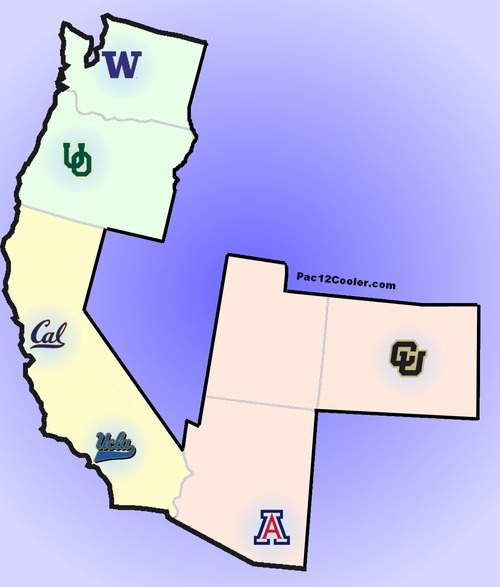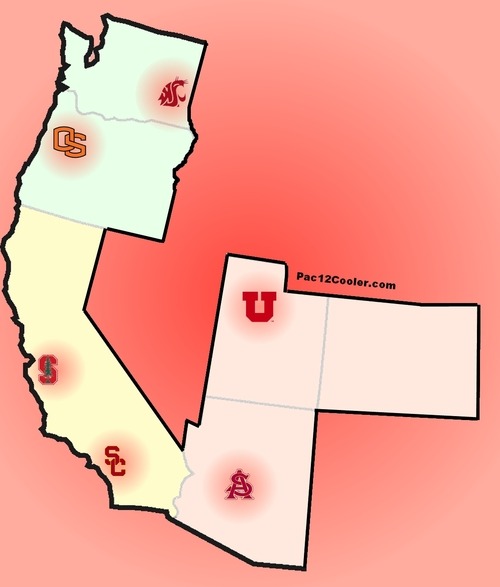Divisions decided
The press conference that just ended announced the new divisions. Here’s a look:

It was also announced that California schools will have a protected rivalry. This DOES ensure that all schools will have three games against a school from each region every year, but it is not truly equal in that regard being that the Northwest schools only get one game against an LA school each year. Still, I applaud the essence of getting the 3/3/3 geography and maintaining rivalries. Here’s a look at the new Pac-12 map:
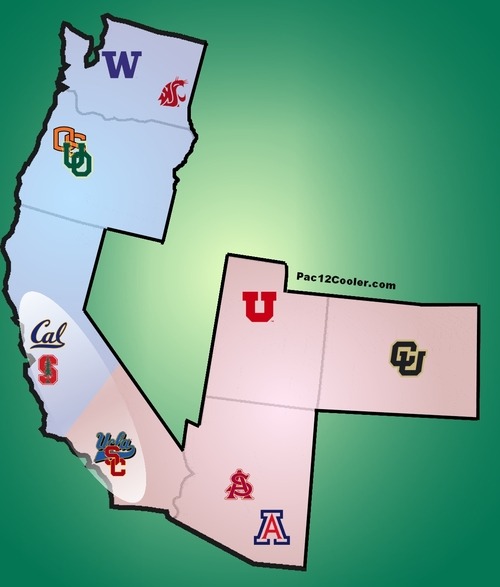
For those of you that watched the press conference, you will notice that my map differs from Larry’s in that the Mountain schools are still north of the bay area schools (Although my map is curved with the earth).
I would first like to say thanks to Larry Scott and the ADs, CEOs, and Presidents for looking at the Cooler plan (which he even mentioned with a smile during the post-conference questions). We had great fan support all around, and I’m really grateful for every comment in a John Wilner post defending the plan even though he wouldn’t mention it. This truly was the plan from the fans, for the fans, supported by the fans. Next I would like to say that I think that Larry Scott did a great job in the process of deciding, even if the Cooler was not selected. He had research firms look at what was best for the conference, which wasn’t what I found, but I assume that they were paid more to figure this stuff out, so I defer my opinion to their’s. It seems as though Larry had it all figured out way back when he told Colorado that they would be with the LA schools and when Larry gets a plan he seems to be determined to see it in action. That is the type of leadership that you want to see at the top of the conference.
As for the schools in particular, they will still play all their old friends, minus a couple schools on a nine game schedule. Even the Northwest schools, the ones being most excluded from Southern California, will still play 6 of their 7 former Pac-8 (the eighth is their own school), so there is something to be said for that. The Arizona schools, #9 and #10 into the conference will likely not care about losing two old foes because Utah and Colorado are closer to Arizona than the North division schools are. Here is a look at the important schedule information:
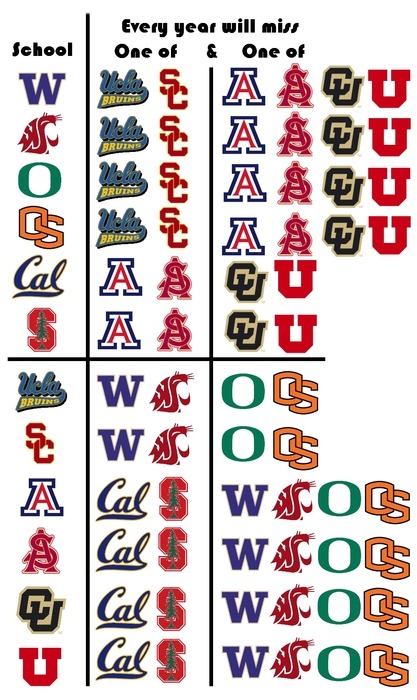
This is based on a small assumption, that being that the Northwest schools will not miss both Southern California schools in any given year, so the Southern California schools will miss one school from each of Oregon and Washington. The other results follow from that. The championship game will be played at the top seed’s home field and revenue sharing will move to equal share, decisions for which I am in favor. I will hold off on any judgements of who got hosed, but I will point out that the Northern California schools seemed to come out the most ahead, as they will continue to play all of their old Pac-8 rivals every year and they don’t have to be atop USC in the standings at the end of the season to make it to the championship game. Although equality is great for building a strong product, if any schools deserve a little bit extra it is probably the NorCal schools, the braintrust of the entire country, not just the Pac-12. Those and Harvard, which taught Larry how to correctly conjugate “Stadium” plurally to “Stadia” in Latin.
As far as the marketing of the divisions goes, I have a few thoughts. The North division is equally West as compared to East, so the divisions could have been named as East and West. The North division is also culturally similar, probably drawing at least a little bit from the (non-WSU) schools all being in the rain shadow west of the Cascades/Sierras producing a very forested land. The Southern schools are all technically in a desert of some kind, although the Arizona schools are the ones that really feel the desert heat. The NorCal schools have to play in the potentially wet and cold environments at 4 Northwest schools late in the year, and the 4 SoCal schools have to play in 2 hot environments and 2 potentially snowy environments. The North aligns Seattle’s Microsoft and Amazon and RealNetworks and Nintendo through the Silicon Forest down to Silicon Valley and Google and HP and Apple and IBM (among others). The South aligns skate boarders with snow boarders and Westwood with Park City and Beaver Creek. On the whole, the divisions seem to fit nicely with themselves, all football aside.
A note on bias for those interested. I am from Oregon, have lived in Washington and New Mexico, currently attend Arizona for my Master’s in Optics, have family in California and good friends at each and every Pac-12 school (except UCLA for some reason), and there is a reasonable chance that come January, I will be working at a job in California, Utah, or Colorado, but certainly will try to stay out in Pac-12 country. Hopefully that comes off as being a good representative of the interests from all regions. And as a side note, all graphics were created with Paint.net, which is freely available and wonderful.
Here’s to hoping that the Pac-12 continues to be the Conference of Champions and that the new TV deal will make us all rich. If I was a North school, I would try to insert a clause into the TV deals about internet (or game console) broadcasting, which I’m thinking some forward-looking bidders in Seattle or Mountain View will be interested in pursuing. I imagine part of the TV deal will include trying to bring the North schools into the Asian market and the South schools into the Latin American market. The future looks bright.
If I have any more big ideas for the future of the Pac-12 (and I have at least one), I will post them here on Pac12Cooler.com in the future, but I will hold off for now. Thanks again for the support everybody!
Pac 12 Cooler Proposal
How the Pac-12 should be split
Current thoughts on the Pac-12 split
There are many AD’s that are not going to like the way that the Pac-12 is split. This is becoming a contentious issue. The Northwest schools are trying to make sure that they retain exposure to the lucrative LA-area recruiting base. The California schools are trying to somehow stay together. Colorado believes that it was promised access to LA. The whole conference wants to maintain regional rivalries. And on top of all this, a zipper must address near-regional rivalries, such as Oregon-Washington.
The most common system to be suggested are a North/South split with Washington, WSU, Oregon, OSU, Cal, and Stanford in the North, but it has also been suggested with Utah and Colorado in the North instead. Utah and Colorado are farther north, and it would help to keep the California schools together, but it would also cut off access to the California market for those teams. With Cal and Stanford in the North, it could also easily be called a West/East split as well as a rainy-green region and a sunny-brown region.
Another suggested split is the zipper-split. This is similar to the ACC split. There are many problems with the ACC split, but they are not problems that couldn’t be overcome. The main advantage of using a zipper system is that it allows all teams to play in all regions of the Pac-12. The big fear however, is that it would ruin rivalries and would make it too complicated to figure out the divisions.
The best split would invariably then come from the compromise, taking the best aspects of each suggestion. It would combine the zipper with the regional matchups.
The “Pac 12 Cooler Proposal”
This proposal is based on the zipper system. The only way that the Northwest schools are going to sign off on an alignment is if they get access to Southern California. In a zipper alignment, one team from each natural-rivalry is put in each division. So Oregon is in a different division than Oregon State and so on. There are now 6 natural rivalries, with Colorado and Utah forming the newest one.
This zipper seeks to put near-natural rivals together as well, placing Oregon and Washington in the same division and UCLA and Cal in the same division, among others. Additionally, there will be cross-division staples to keep the geographic rivalries intact.
The proposed alignment is (with the divisions on the left and right):
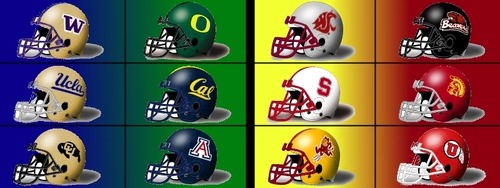
Teams would always play their side of the graphic, PLUS the teams in their row every season. Then they would play 2 of the remaining 4 teams. This results in every team playing every other team twice out of every four years, and at least once in each stadium over a four-year college career. All teams would have exposure to each region of the Pac-10 every year and would also play all their regional rivals.
Examples:
Washington always plays (Oregon, Oregon State, Washington State, Cal, UCLA, Arizona, and Colorado) and two of (Stanford, USC, ASU, Utah)
USC always plays (Cal, Stanford, UCLA, Oregon State, Washington State, Arizona State, and Utah) and two of (Washington, Oregon, Arizona, Colorado)
Colorado always plays (Arizona, Arizona State, Utah, Washington, Oregon, Cal, UCLA) and two of (Stanford, USC, Washington State, Oregon State).
Making sense of the divisions
Teams play their local rivals, they also play their near-local rivals (UCLA-Cal, UW-UO…), they also all get exposure to every region of the Pac-12, and the league is broken up so that teams on the left side will be happy with their division and the teams on the right side will be happy with their division (with the possible exception of USC, which may feel it does not bring in as many big names anymore, but will be rewarded with an easier path (traditionally) to the championship game. Additionally, as the image suggests, there will be some ease in figuring out which team is in which division, unlike the ACC, in that all the “State” schools and all the private schools are grouped with the new-to-AQ member, and all the teams without those modifiers are in the other division. Additionally, all the teams that lean more towards the warm colors are in one division and all the teams that lean towards the cool colors are in the other. Strangely enough, the left side tends to lean left politically (and blue is a cool color) and the right side tends to lean right (and red is a warm color). Using this graphic, it looks like the teams should be split up this way. The competition is balanced with USC on the right half and the combination of the minor powers in the left half.
Historically the left half of this division is has 53 Pac-10 championships (UCLA=17, UW=15, Cal=13, Oregon=7, Arizona=1, Colorado=0), while the right half of this division has 56 championships (USC=32, Stanford=12, OSU=5, WSU=4, ASU=3, Utah=0). So the competitive balance appears to be in place with this split, with respect to conference champions.
Rivalries and Analysis
It has been suggested that there are problems with, for example, Oregon not playing USC every year. They would, however, play two of every four years and at least once in each other’s stadium during each four-year college career. Additionally, with this setup, it is more likely that if USC is playing really well, then missing USC for Oregon will result in an easier road to the championship game, where they will face USC. It also means that matches like Oregon-Washington will have increased value in the division and conference races.
Some rivalries will have to be broken no matter what, barring an 11-game conference schedule. This is likely the least upsetting of the alignments. It satisfies almost all of the potential complaints about the way the Pac-12 could be split up, while making the divisions at least pass the look test for competitiveness. The only other issue would be repeat games, with rivals playing each other in the final week and then also in the championship game. This could be easily solved by making the rule that only the winner of the natural-rivalry can play in the conference championship game, if both are slated to make it there.
The only problem with these divisions is that they need to have names.
Updated: New visual aids for the divisions

